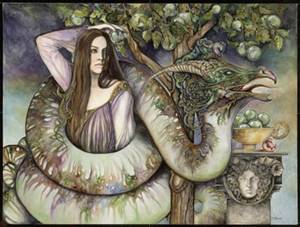
Let us bear in mind that the bible is not meant to be a scientific explanation of the beginnings of time. It is meant to give us the “inspired” explanation and reflections of the biblical authors regarding God’s purpose and humanity’s response. A scientific explanation is meant to explain HOW the universe came to be. A biblical explanation is meant to explain WHY it came to be.
The stories of Creation and the Fall are myths, but I should caution you against thinking that simply because these are myths, then therefore these are false. A myth is a literary form, usually using figurative language, which is used in explaining the origins of natural phenomena and aspects of human behavior. The story presented in a myth may not have truly happened but contains profound truths nevertheless. The Catechism of the Catholic Church also tells us that the account of the Fall uses figurative language (CCC, 390).
Analysing the creation story as a “myth” actually provides us profound insights on God’s purposes and humanity’s response. On the other hand, if you simply take the creation story literally, then you would probably deduce that God is a mighty and fast worker who created everything in six days, got tired and rested on the seventh day.
Here are some of the meanings we can learn from these two stories:
1. God is the source of everything. The first verse in the bible is “in the beginning, the earth was a formless wasteland, and the darkness covered the abyss.” Then God created the heavens and the earth. Before that, there was nothing. The phrase “and God said” indicates the power of God: simply by God’s word, things came to be. (In Tagalog, isang salita lang, naganap na.)
2. God’s creation is perfect; nothing more and nothing less are required. The number “7” is a symbol (as all numbers in the bible are symbolic) which means “perfect” or “complete.” There is a sequence to creation (from Day 1 to Day 6), which means there is a purpose in creation. Its purpose is to share God’s love and goodness – “God saw it was good.” The purpose of creation is also shown on the seventh day which is blessed and made holy; meaning, that the purpose is for humanity to be with God.
3. Humanity is the most important of all creation. God reserved the best for last, and only man/woman were created “in the image of God.” God’s original intent is for harmony between God, humanity, and creation. It was paradise. But Adam and Eve broke this harmony with their response to God’s purposes.
4. The “tree of knowledge of good and evil” is a merism, which is a literary device by which totality is expressed by the first and last of a series or by opposites. For example: “you know when I sit and when I stand” means all my physical movement. Or “I love you day and night” means we love the person all the time.
“To know” means not just intellectual, but experiential and relational so to “eat of the tree of knowledge of good and evil” actually refers to a mastery of life which is independent of God. The original sin is more than just disobedience. Sometime in the beginnings of human history, humanity took a position that did not recognize the superiority of God and therefore rejected God’s love.
This rejection of God’s love has resulted to a state of “original sin.” Try to look at original sin not just as “an act,” but as a state or condition which now characterizes humanity. We now have this tendency to be selfish (to think myself first). Thus, we harm human relationships and promote certain sinful and unjust structures in society which oppress others.
There is one other aspect in the story of the Fall which is often neglected. In Genesis 3:21, it says: “For the man and his wife, the LORD God made leather garments, with which he clothed them.” This was after they took of the fruit and before they were banished from the garden. This is a symbol that God always gives sinful persons a second chance.
And indeed, we see this message clearly in Jesus Christ, the image of the invisible God, who came for us sinners.